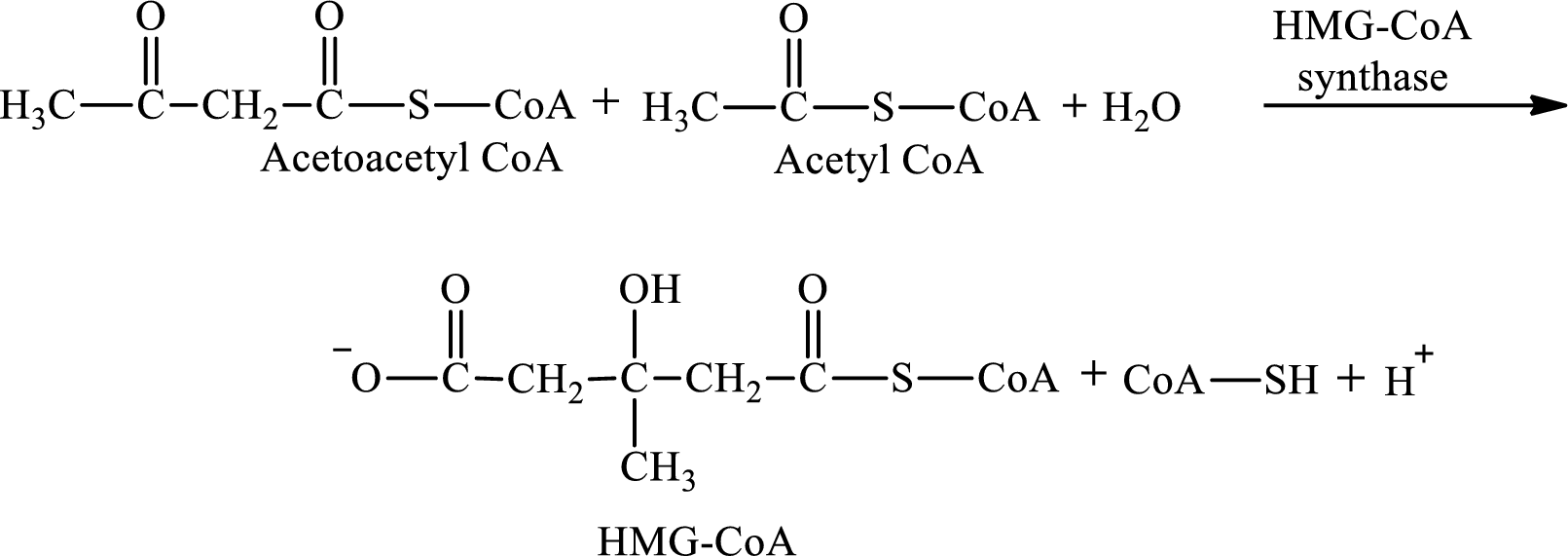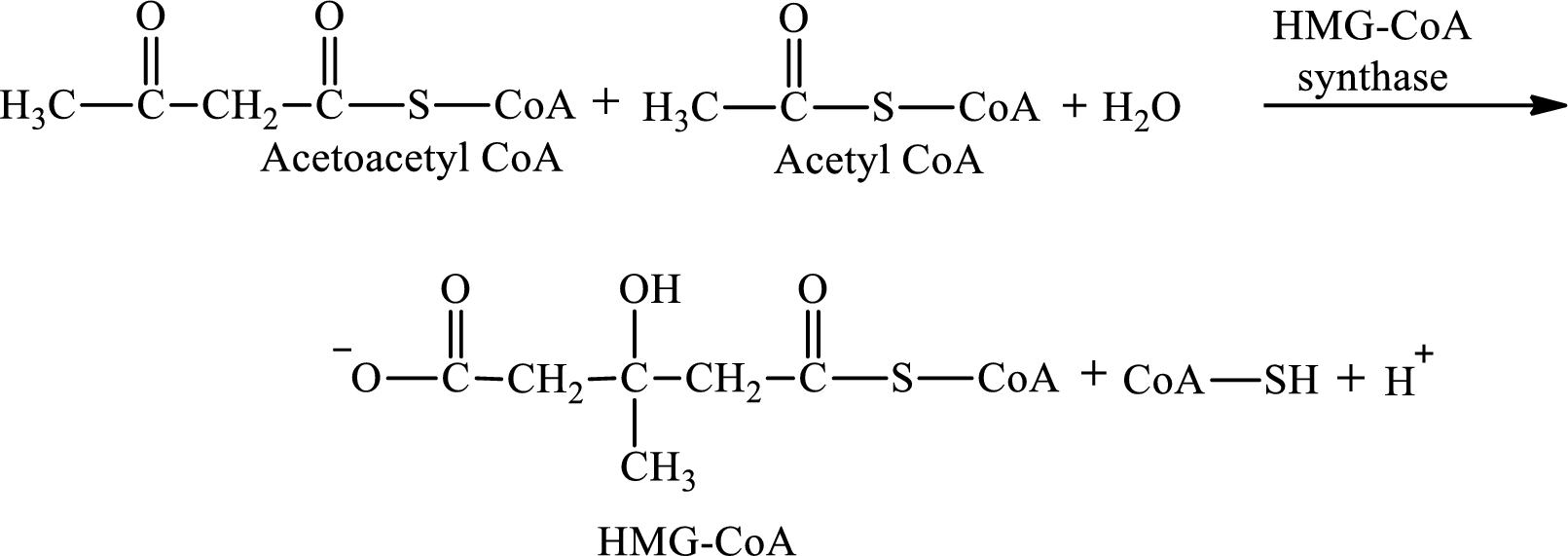
Concept explainers
(a)
Interpretation:
HMG-CoA is encountered in the process (1) glycerol
Concept introduction:
Lipogenesis is the process employed for the synthesis of fatty acid. The starting precursor for the synthesis is acetyl CoA. The enzyme employed for the process is fatty acid synthase. It is a multienzyme complex that ties the reaction responsible for the synthesis of fatty acid. The fatty acid is synthesized in two parts. In the first part, there is citrate-malate shuttle system and in the second part, there is a cyclic process to synthesize saturated fatty acid.
The fatty acids are broken down to provide energy. The breakdown of fatty acids is a three parts process. In the first part, the fatty acid is activated. In the second part, the transportation of fatty acid into the mitochondrial matrix is facilitated by a shuttle mechanism. In the third part, the fatty acid is readily oxidized, cycling through a series of four reactions. In these series of reactions, acyl CoA is degraded to acetyl CoA. This pathway is termed as β-oxidation pathway.
Ketogenesis is a metabolic process by which
Triacylglycerol mobilization is an ongoing process in which triacylglycerols that are stored in the adipose tissue are hydrolyzed. Fatty acids and glycerol are the products of triacylglycerol mobilization. The products are released into the bloodstream.
After entering the bloodstream, the glycerol travels to the kidneys or liver. The first stage of glycerol metabolism occurs in the liver or kidney where it is converted to
(a)
Answer to Problem 25.104EP
HMG-CoA is encountered in ketogenesis.
Explanation of Solution
HMG-CoA is produced in step 2 in ketogenesis.
Step 2 is a condensation reaction. In step 2, acetoacetyl CoA reacts with acetyl CoA and water to produce 3-hydroxyl-3-methylglutaryl (HMG-CoA) and CoA-SH. The reaction for step 2 is:

(b)
Interpretation:
NADPH is encountered in the process (1) glycerol metabolism to dihydroxyacetone phosphate, (2) β-oxidation pathway, (3) ketogenesis, and (4) lipogenesis has to be identified.
Concept introduction:
Lipogenesis is the process employed for the synthesis of fatty acid. The starting precursor for the synthesis is acetyl CoA. The enzyme employed for the process is fatty acid synthase. It is a multienzyme complex that ties the reaction responsible for the synthesis of fatty acid. The fatty acid is synthesized in two parts. In the first part, there is citrate-malate shuttle system and in the second part, there is a cyclic process to synthesize saturated fatty acid.
The fatty acids are broken down to provide energy. The breakdown of fatty acids is a three parts process. In the first part, the fatty acid is activated. In the second part, the transportation of fatty acid into the mitochondrial matrix is facilitated by a shuttle mechanism. In the third part, the fatty acid is readily oxidized, cycling through a series of four reactions. In these series of reactions, acyl CoA is degraded to acetyl CoA. This pathway is termed as β-oxidation pathway.
Ketogenesis is a metabolic process by which ketone bodies are produced by the breakdown of fatty acids and ketogenic amino acids. This metabolic process supplies our organs with needed energy under certain circumstances such as starvation. Fatty acid molecules degrade into acetyl CoA which are utilized as reactants in the process of ketogenesis. These molecules of acetyl CoA undergo the process of condensation twice, followed by chain cleavage and hydrogenation to produce ketone bodies.
Triacylglycerol mobilization is an ongoing process in which triacylglycerols that are stored in the adipose tissue are hydrolyzed. Fatty acids and glycerol are the products of triacylglycerol mobilization. The products are released into the bloodstream.
After entering the bloodstream, the glycerol travels to the kidneys or liver. The first stage of glycerol metabolism occurs in the liver or kidney where it is converted to
(b)
Answer to Problem 25.104EP
NADPH is encountered in lipogenesis.
Explanation of Solution
NADPH acts as the reducing agent in step 2 and 4 of the cyclic process of lipogenesis. NADPH gets oxidized to form NADP+.
Step 2 involves the hydrogenation of acetoacetyl ACP to synthesis β-hydroxybutyrylwith the help of reducing agent NADPH. The reaction of this step is:

Step 4 again involves hydrogenation reaction. In this step, crotonyl ACP is converted to butyryl ACP with the help of reducing agent NADPH. The reaction of this step is:

(c)
Interpretation:
Malonyl ACP is encountered in the process (1) glycerol metabolism to dihydroxyacetone phosphate, (2) β-oxidation pathway, (3) ketogenesis, and (4) lipogenesis has to be identified.
Concept introduction:
Lipogenesis is the process employed for the synthesis of fatty acid. The starting precursor for the synthesis is acetyl CoA. The enzyme employed for the process is fatty acid synthase. It is a multienzyme complex that ties the reaction responsible for the synthesis of fatty acid. The fatty acid is synthesized in two parts. In the first part, there is citrate-malate shuttle system and in the second part, there is a cyclic process to synthesize saturated fatty acid.
The fatty acids are broken down to provide energy. The breakdown of fatty acids is a three parts process. In the first part, the fatty acid is activated. In the second part, the transportation of fatty acid into the mitochondrial matrix is facilitated by a shuttle mechanism. In the third part, the fatty acid is readily oxidized, cycling through a series of four reactions. In these series of reactions, acyl CoA is degraded to acetyl CoA. This pathway is termed as β-oxidation pathway.
Ketogenesis is a metabolic process by which ketone bodies are produced by the breakdown of fatty acids and ketogenic amino acids. This metabolic process supplies our organs with needed energy under certain circumstances such as starvation. Fatty acid molecules degrade into acetyl CoA which are utilized as reactants in the process of ketogenesis. These molecules of acetyl CoA undergo the process of condensation twice, followed by chain cleavage and hydrogenation to produce ketone bodies.
Triacylglycerol mobilization is an ongoing process in which triacylglycerols that are stored in the adipose tissue are hydrolyzed. Fatty acids and glycerol are the products of triacylglycerol mobilization. The products are released into the bloodstream.
After entering the bloodstream, the glycerol travels to the kidneys or liver. The first stage of glycerol metabolism occurs in the liver or kidney where it is converted to
(c)
Answer to Problem 25.104EP
Malonyl ACP is encountered in lipogenesis.
Explanation of Solution
Malonyl ACP is the reactant in step 1 in the cyclic process in lipogenesis.
The first step involves the condensation reaction between acetyl ACP and malonyl ACP. The product formed in the first reaction is acetoacetyl ACP. The reaction of step 1 is:

(d)
Interpretation:
Acetoacetyl CoA is encountered in the process (1) glycerol metabolism to dihydroxyacetone phosphate, (2) β-oxidation pathway, (3) ketogenesis, and (4) lipogenesis has to be identified.
Concept introduction:
Lipogenesis is the process employed for the synthesis of fatty acid. The starting precursor for the synthesis is acetyl CoA. The enzyme employed for the process is fatty acid synthase. It is a multienzyme complex that ties the reaction responsible for the synthesis of fatty acid. The fatty acid is synthesized in two parts. In the first part, there is citrate-malate shuttle system and in the second part, there is a cyclic process to synthesize saturated fatty acid.
The fatty acids are broken down to provide energy. The breakdown of fatty acids is a three parts process. In the first part, the fatty acid is activated. In the second part, the transportation of fatty acid into the mitochondrial matrix is facilitated by a shuttle mechanism. In the third part, the fatty acid is readily oxidized, cycling through a series of four reactions. In these series of reactions, acyl CoA is degraded to acetyl CoA. This pathway is termed as β-oxidation pathway.
Ketogenesis is a metabolic process by which ketone bodies are produced by the breakdown of fatty acids and ketogenic amino acids. This metabolic process supplies our organs with needed energy under certain circumstances such as starvation. Fatty acid molecules degrade into acetyl CoA which are utilized as reactants in the process of ketogenesis. These molecules of acetyl CoA undergo the process of condensation twice, followed by chain cleavage and hydrogenation to produce ketone bodies.
Triacylglycerol mobilization is an ongoing process in which triacylglycerols that are stored in the adipose tissue are hydrolyzed. Fatty acids and glycerol are the products of triacylglycerol mobilization. The products are released into the bloodstream.
After entering the bloodstream, the glycerol travels to the kidneys or liver. The first stage of glycerol metabolism occurs in the liver or kidney where it is converted to
(d)
Answer to Problem 25.104EP
Acetoacetyl CoA is encountered in ketogenesis.
Explanation of Solution
Step 2 is a condensation reaction. In step 2, acetoacetyl CoA reacts with acetyl CoA and water to produce 3-hydroxyl-3-methylglutaryl (HMG-CoA) and CoA-SH. The reaction for step 2 is:

Want to see more full solutions like this?
Chapter 25 Solutions
Bundle: General, Organic, and Biological Chemistry, 7th + OWLv2 Quick Prep for General Chemistry, 4 terms (24 months) Printed Access Card
- In the decomposition reaction in solution B → C, only species C absorbs UV radiation, but neither B nor the solvent absorbs. If we call At the absorbance measured at any time, A0 the absorbance at the beginning of the reaction, and A∞ the absorbance at the end of the reaction, which of the expressions is valid? We assume that Beer's law is fulfilled.arrow_forward> You are trying to decide if there is a single reagent you can add that will make the following synthesis possible without any other major side products: 1. ☑ CI 2. H3O+ O Draw the missing reagent X you think will make this synthesis work in the drawing area below. If there is no reagent that will make your desired product in good yield or without complications, just check the box under the drawing area and leave it blank. Click and drag to start drawing a structure. Explanation Check ? DO 18 Ar B © 2025 McGraw Hill LLC. All Rights Reserved. Terms of Use | Privacy Center | Accessibilityarrow_forwardDon't use ai to answer I will report you answerarrow_forward
- Consider a solution of 0.00304 moles of 4-nitrobenzoic acid (pKa = 3.442) dissolved in 25 mL water and titrated with 0.0991 M NaOH. Calculate the pH at the equivalence pointarrow_forwardWhat is the name of the following compound? SiMe3arrow_forwardK Draw the starting structure that would lead to the major product shown under the provided conditions. Drawing 1. NaNH2 2. PhCH2Br 4 57°F Sunny Q Searcharrow_forward
- 7 Draw the starting alkyl bromide that would produce this alkyne under these conditions. F Drawing 1. NaNH2, A 2. H3O+ £ 4 Temps to rise Tomorrow Q Search H2arrow_forward7 Comment on the general features of the predicted (extremely simplified) ¹H- NMR spectrum of lycopene that is provided below. 00 6 57 PPM 3 2 1 0arrow_forwardIndicate the compound formula: dimethyl iodide (propyl) sulfonium.arrow_forward
 Chemistry for Today: General, Organic, and Bioche...ChemistryISBN:9781305960060Author:Spencer L. Seager, Michael R. Slabaugh, Maren S. HansenPublisher:Cengage Learning
Chemistry for Today: General, Organic, and Bioche...ChemistryISBN:9781305960060Author:Spencer L. Seager, Michael R. Slabaugh, Maren S. HansenPublisher:Cengage Learning General, Organic, and Biological ChemistryChemistryISBN:9781285853918Author:H. Stephen StokerPublisher:Cengage Learning
General, Organic, and Biological ChemistryChemistryISBN:9781285853918Author:H. Stephen StokerPublisher:Cengage Learning Organic And Biological ChemistryChemistryISBN:9781305081079Author:STOKER, H. Stephen (howard Stephen)Publisher:Cengage Learning,
Organic And Biological ChemistryChemistryISBN:9781305081079Author:STOKER, H. Stephen (howard Stephen)Publisher:Cengage Learning, Introduction to General, Organic and BiochemistryChemistryISBN:9781285869759Author:Frederick A. Bettelheim, William H. Brown, Mary K. Campbell, Shawn O. Farrell, Omar TorresPublisher:Cengage Learning
Introduction to General, Organic and BiochemistryChemistryISBN:9781285869759Author:Frederick A. Bettelheim, William H. Brown, Mary K. Campbell, Shawn O. Farrell, Omar TorresPublisher:Cengage Learning



